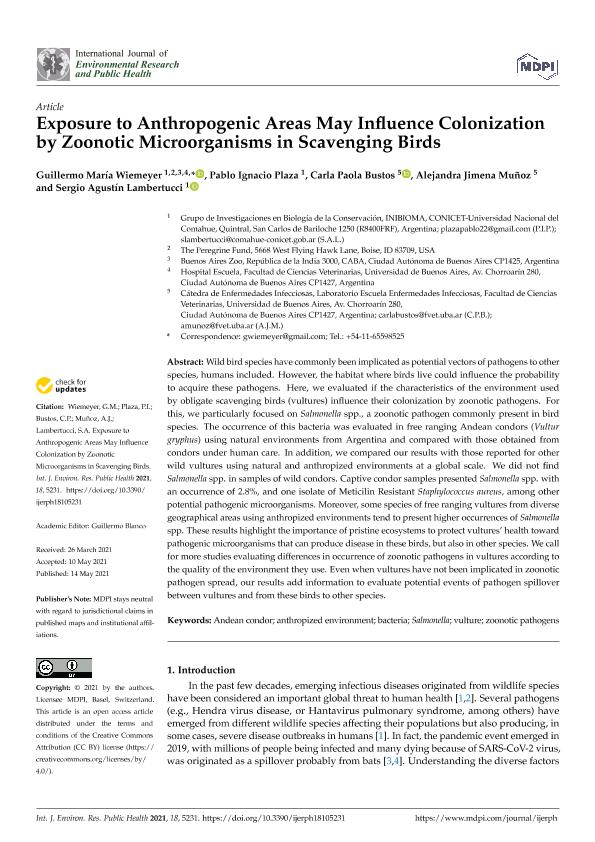Mostrar el registro sencillo del ítem
dc.contributor.author
Wiemeyer, Guillermo Maria

dc.contributor.author
Plaza, Pablo

dc.contributor.author
Bustos, Carla Paola

dc.contributor.author
Muñoz, Alejandra Jimena

dc.contributor.author
Lambertucci, Sergio Agustin

dc.date.available
2023-01-09T14:56:47Z
dc.date.issued
2021-05
dc.identifier.citation
Wiemeyer, Guillermo Maria; Plaza, Pablo; Bustos, Carla Paola; Muñoz, Alejandra Jimena; Lambertucci, Sergio Agustin; Exposure to anthropogenic areas may influence colonization by zoonotic microorganisms in scavenging birds; Molecular Diversity Preservation International; International Journal of Environmental Research and Public Health; 18; 10; 5-2021; 1-14
dc.identifier.issn
1660-4601
dc.identifier.uri
http://hdl.handle.net/11336/183921
dc.description.abstract
Wild bird species have commonly been implicated as potential vectors of pathogens to other species, humans included. However, the habitat where birds live could influence the probability to acquire these pathogens. Here, we evaluated if the characteristics of the environment used by obligate scavenging birds (vultures) influence their colonization by zoonotic pathogens. For this, we particularly focused on Salmonella spp., a zoonotic pathogen commonly present in bird species. The occurrence of this bacteria was evaluated in free ranging Andean condors (Vultur gryphus) using natural environments from Argentina and compared with those obtained from condors under human care. In addition, we compared our results with those reported for other wild vultures using natural and anthropized environments at a global scale. We did not find Salmonella spp. in samples of wild condors. Captive condor samples presented Salmonella spp. with an occurrence of 2.8%, and one isolate of Meticilin Resistant Staphylococcus aureus, among other potential pathogenic microorganisms. Moreover, some species of free ranging vultures from diverse geographical areas using anthropized environments tend to present higher occurrences of Salmonella spp. These results highlight the importance of pristine ecosystems to protect vultures’ health toward pathogenic microorganisms that can produce disease in these birds, but also in other species. We call for more studies evaluating differences in occurrence of zoonotic pathogens in vultures according to the quality of the environment they use. Even when vultures have not been implicated in zoonotic pathogen spread, our results add information to evaluate potential events of pathogen spillover between vultures and from these birds to other species.
dc.format
application/pdf
dc.language.iso
eng
dc.publisher
Molecular Diversity Preservation International

dc.rights
info:eu-repo/semantics/openAccess
dc.rights.uri
https://creativecommons.org/licenses/by/2.5/ar/
dc.subject
ANDEAN CONDOR
dc.subject
ANTHROPIZED ENVIRONMENT
dc.subject
BACTERIA
dc.subject
SALMONELLA
dc.subject
VULTURE
dc.subject
ZOONOTIC PATHOGENS
dc.subject.classification
Salud Pública y Medioambiental

dc.subject.classification
Ciencias de la Salud

dc.subject.classification
CIENCIAS MÉDICAS Y DE LA SALUD

dc.title
Exposure to anthropogenic areas may influence colonization by zoonotic microorganisms in scavenging birds
dc.type
info:eu-repo/semantics/article
dc.type
info:ar-repo/semantics/artículo
dc.type
info:eu-repo/semantics/publishedVersion
dc.date.updated
2022-10-06T13:14:54Z
dc.identifier.eissn
1661-7827
dc.journal.volume
18
dc.journal.number
10
dc.journal.pagination
1-14
dc.journal.pais
Suiza

dc.journal.ciudad
Basilea
dc.description.fil
Fil: Wiemeyer, Guillermo Maria. Universidad de Buenos Aires. Facultad de Ciencias Veterinarias; Argentina. Consejo Nacional de Investigaciones Científicas y Técnicas. Centro Científico Tecnológico Conicet - Patagonia Norte. Instituto de Investigaciones en Biodiversidad y Medioambiente. Universidad Nacional del Comahue. Centro Regional Universidad Bariloche. Instituto de Investigaciones en Biodiversidad y Medioambiente; Argentina. Buenos Aires Zoo; Argentina. The Peregrine Fund; Estados Unidos
dc.description.fil
Fil: Plaza, Pablo. Universidad Nacional del Comahue. Centro Regional Universitario Bariloche; Argentina. Consejo Nacional de Investigaciones Científicas y Técnicas. Centro Científico Tecnológico Conicet - Patagonia Norte. Instituto de Investigaciones en Biodiversidad y Medioambiente. Universidad Nacional del Comahue. Centro Regional Universidad Bariloche. Instituto de Investigaciones en Biodiversidad y Medioambiente; Argentina
dc.description.fil
Fil: Bustos, Carla Paola. Consejo Nacional de Investigaciones Científicas y Técnicas. Centro Científico Tecnológico Conicet - Patagonia Norte. Instituto de Investigaciones en Biodiversidad y Medioambiente. Universidad Nacional del Comahue. Centro Regional Universidad Bariloche. Instituto de Investigaciones en Biodiversidad y Medioambiente; Argentina. Universidad de Buenos Aires. Facultad de Ciencias Veterinarias; Argentina
dc.description.fil
Fil: Muñoz, Alejandra Jimena. Consejo Nacional de Investigaciones Científicas y Técnicas; Argentina. Universidad de Buenos Aires. Facultad de Ciencias Veterinarias; Argentina
dc.description.fil
Fil: Lambertucci, Sergio Agustin. Consejo Nacional de Investigaciones Científicas y Técnicas. Centro Científico Tecnológico Conicet - Patagonia Norte. Instituto de Investigaciones en Biodiversidad y Medioambiente. Universidad Nacional del Comahue. Centro Regional Universidad Bariloche. Instituto de Investigaciones en Biodiversidad y Medioambiente; Argentina
dc.journal.title
International Journal of Environmental Research and Public Health

dc.relation.alternativeid
info:eu-repo/semantics/altIdentifier/url/https://www.mdpi.com/1660-4601/18/10/5231
dc.relation.alternativeid
info:eu-repo/semantics/altIdentifier/doi/https://doi.org/10.3390/ijerph18105231
Archivos asociados
